Rabdi Recipe
Rabdi is classic Indian dessert where milk is simmered on low heat until it thickens and then often flavored with cardamom, saffron and nuts!
This post may contain affiliate links. Please read our disclosure policy.
Rabdi is the simplest Indian dessert which is made by simmering the milk on low heat until it reduces to 1/3rd to 1/4th of it’s original volume.
It’s often flavored with nuts, cardamom, saffron and served in earthen clay pots.
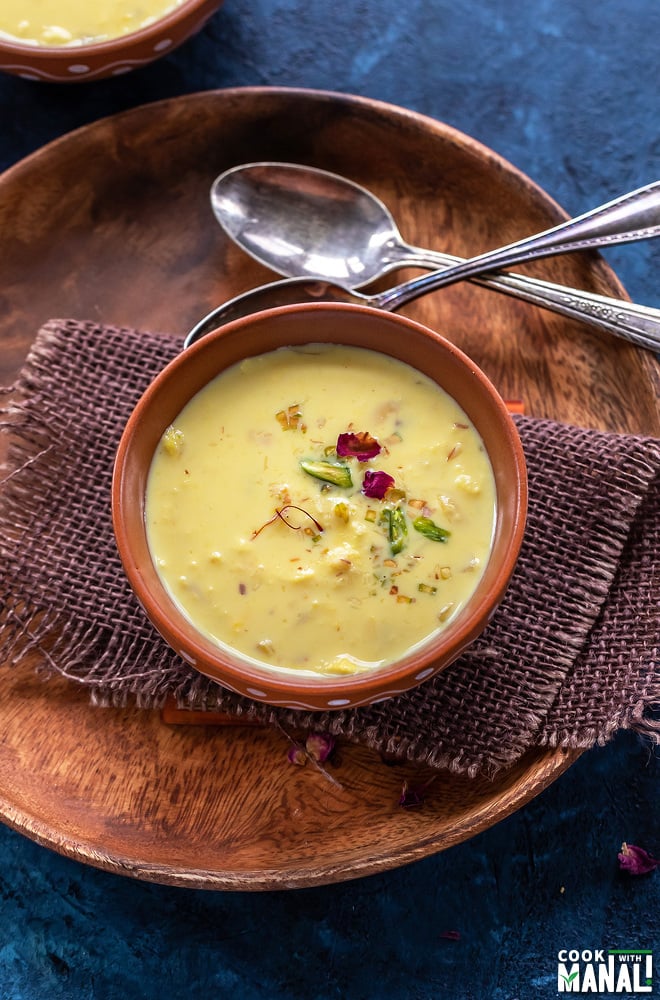
When I was a kid, all my favorite desserts were the ones my nani (grandmother) made.
Since milk was the only thing readily available in the village in those times, all her desserts were made with milk or milk based products.
Her peda was of course my favorite and another dessert that was often made was Rabdi.
What is Rabdi
Rabdi or rabri in simple words in just reduced milk with malai (cream).
It’s usually made with whole milk which is simmered on low heat for a long time until it reduces to 1/3rd or 1/4th of it’s original volume.
As you can imagine this takes time, so rabdi is definitely not a dessert which you can whip up in 15 minutes!
It’s then sweetened with sugar and flavored with saffron, cardamom, rose etc. It’s also usually has lots of nuts added to it.
There are several shot cut methods of making rabdi, using ricotta cheese, using condensed milk and there’s nothing wrong with those.
However if you want the real taste of rabdi, then really there’s no easy way. The thickened milk has a different aroma and flavor of it’s own and you cannot get that with these “cheat” recipes.
Honestly, I don’t find making rabdi a very tedious process mostly because I make it on the side when I am doing something else.
So, the other day when I was making rabdi, I actually made my entire lunch, organized my pantry and all this while rabdi was cooking on the side.
If you club it with something else, then the process doesn’t feel that long. You only need to stir in once in 10 minutes or so.
Important Tips to Make Rabdi
Use a heavy bottom good quality pot: this is super important. I love using my all clad steel pot to make rabdi. If the pot isn’t heavy enough then the milk will stick to it and burn.
Also, I stir after every 10 minutes or so since the I want the cream to form on top and if you are going to leave the pot unattended and stir every 10 minutes or so then the pot needs to heavy and good quality.
Else the milk will get stuck to the bottom of the pan and burn and the whole taste of your rabdi will be spoiled.
Use whole milk: for best results, whole milk works best. The fat free or low fat milk doesn’t give the same texture to the rabdi.
Malai rabdi or Smooth Rabdi: this is totally a personal choice.
If you want malai in rabdi- then follow my recipe as it is. Simply collect all the cream that forms on top and stick it to the sides of the pot.
Keep doing this until the milk reduces to 1/3rd of it’s volume (or 1/4 if you want) and in the very end, scrape all the cream and stir it into the rabdi. This is lachcha rabdi, and it will have lot of texture.
If you prefer smooth rabdi- don’t let the cream on top of the milk form, keep stirring often and it won’t form. You will just have thick smooth rabdi at the end.
So make it the way you like your rabdi.
Adding flavors: you can flavor your rabdi any way you like. Sarvesh actually prefers plain rabdi without anything- no nuts, no saffron, just a hint of cardamom and that’s all.
I on the other hand, like adding saffron, rose water to my rabdi. Even kewra water goes so well. So again, it’s a personal preference how you want to flavor your rabdi.
Serving Suggestions
Rabdi can be served as such as a dessert.
Or it’s most popular combinations are with malpua and jalebi.
Some people also love it with paratha and puri.
Method
1- Add whole milk (we are using 1.5 liters/6 cups milk here) to a heavy bottom pot on medium heat.
2- Once it becomes little warm, take 1-2 tablespoons of milk from the pot and add it to a separate bowl/container. Now take a pinch of saffron strands, crush between you palm and add it to the warm milk. Set aside.
3- Meanwhile add nuts to a pan of water and let it heat up. Let the nuts remain in hot water for 15 minutes while you are working on the recipe. And once 15 minutes are up, then remove the skin and chop/slice the nuts. I have used only almonds here, you can use cashews, pistachios etc.
4- Back to the milk now, let the milk come to a gentle boil. And once it has come to a boil, reduce the heat to medium-low.
5- Let the milk simmer on low heat, do not stir and after 5 minutes or so you will notice that layer of cream (malai) will start forming on top of the milk. With a spatula or spoon, pick this cream top and stick it to the sides of the pan. You can then give a gentle stir to the milk and then let it simmer again.
6- Keep doing this process of collecting the cream top and sticking it to the sides as the milk simmers. Do this every 10 minutes or so when the cream forms, and do not stir it in between. Because if you stir then the cream top won’t form.
On another note- if you want a smooth rabdi, then keep stirring the milk often and don’t do this step of sticking the cream to the sides.
7- After around 35 minutes (from the time it came to a boil), the milk has reduced to half (3 cups). At this point add in the sugar and mix.
8- Also add the prepared saffron milk that we had prepared earlier. Stir and continue to simmer the milk and collect the cream top on the sides.
9- After additional 30-40 minutes, the milk has now reduced to 1/3rd of it’s original volume (total time taken from the point it started boiling to reach this stage was 1 hour 20 minutes). At this point add chopped nuts.
10- Also add cardamom powder and rose water and stir.
11- Now scrape all the malai (cream) from the sides using a spatula that you had collected all this while and mix it with the reduced milk.
12- Remove pot from heat and rabdi is now ready. As you can see the final volume of the rabdi was 2 cups (we started with 6 cups). If you want, you can even reduce it further to 1/4th of it’s original volume which will be 1.5 cups.
Chill the rabdi and garnish with more nuts before serving!
If you’ve tried this Rabdi Recipe then don’t forget to rate the recipe! You can also follow me on Facebook and Instagram to see what’s latest in my kitchen!
Rabdi Recipe
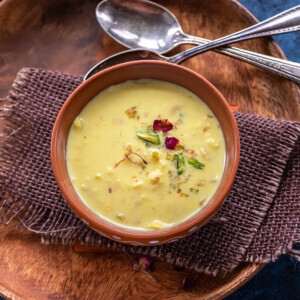
Ingredients
- 1.5 liters whole milk 6 cups
- generous pinch saffron strands
- 12 almonds sliced or chopped
- 1/4 cup granulated white sugar 50 grams, or adjust to taste
- 1/4 teaspoon cardamom powder
- 1/2 teaspoon rose water or adjust to taste
Instructions
- Add whole milk (we are using 1.5 liters/6 cups milk here) to a heavy bottom pot on medium heat.
- Once it becomes little warm, take 1-2 tablespoons of milk from the pot and add it to a separate bowl/container. Now take a pinch of saffron strands, crush between you palm and add it to the warm milk. Set aside.Meanwhile add nuts to a pan of water and let it heat up. Let the nuts remain in hot water for 15 minutes while you are working on the recipe. And once 15 minutes are up, then remove the skin and chop or slice the nuts. I have used only almonds here, you can use cashews, pistachios etc.
- Back to the milk now, let the milk come to a gentle boil. And once it has come to a boil, reduce the heat to medium-low.Let the milk simmer on low heat, do not stir and after 5 minutes or so you will notice that layer of cream starts forming on top of the milk. With a spatula or spoon, pick this cream top and stick it to the sides of the pan. You can then give a gentle stir to the milk and then let it simmer again.
- Keep doing this process of collecting the cream top and sticking it to the sides as the milk simmers. Do this every 10 minutes or so when the cream forms, and do not stir it in between. Because if you stir then the cream top won't form.On another note- if you want a smooth rabdi, then keep stirring the milk often and don't do this step of sticking the cream on the sides.
- After around 35 minutes (from the time it came to a boil), the milk has reduced to half (3 cups). At this point add in the sugar and mix.
- Also add the prepared saffron milk that we had prepared earlier. Stir and continue to simmer the milk and collect the cream top on the sides.
- After additional 30-40 minutes, the milk has now reduced to 1/3rd of it's original volume (total time taken from the point it started boiling to reach this stage was 1 hour 20 minutes). At this point add chopped nuts.Also add cardamom powder and rose water and stir.
- Now scrape all the malai (cream) from the sides using a spatula that you had collected all this while and mix it with the reduced milk.
- Remove pot from heat and rabdi is now ready. As you can see the final volume of the rabdi was 2 cups (we started with 6 cups). If you want, you can even reduce it further to 1/4th of it's original volume which will be 1.5 cups. Chill the rabdi and garnish with more nuts before serving!
Notes
- Calories calculated is for 1 cup of rabdi.
- Sweetness can be adjusted to taste. This rabdi is lightly sweetened, add additional 1-2 tablespoons of sugar if you prefer sweeter rabdi.
- You can also flavor the rabdi with kewra water.
- The milk should be simmered on medium low to low heat throughout.
Nutrition
Nutrition information is automatically calculated, so should only be used as an approximation.
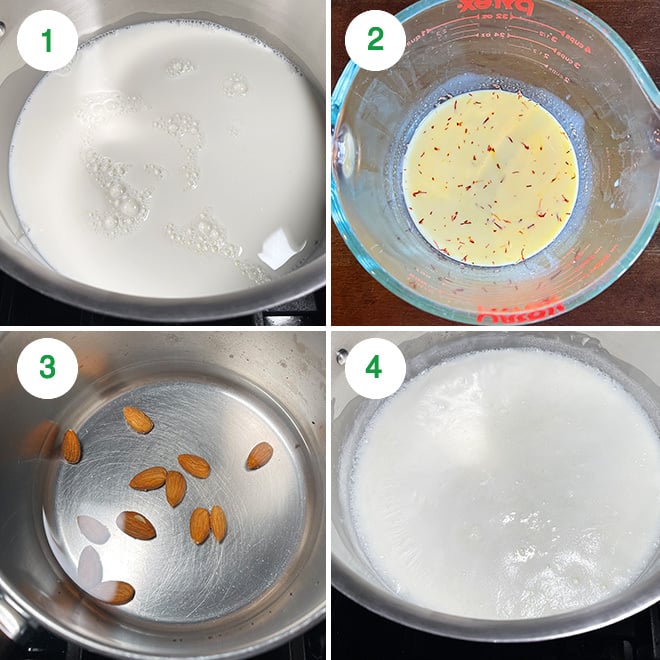
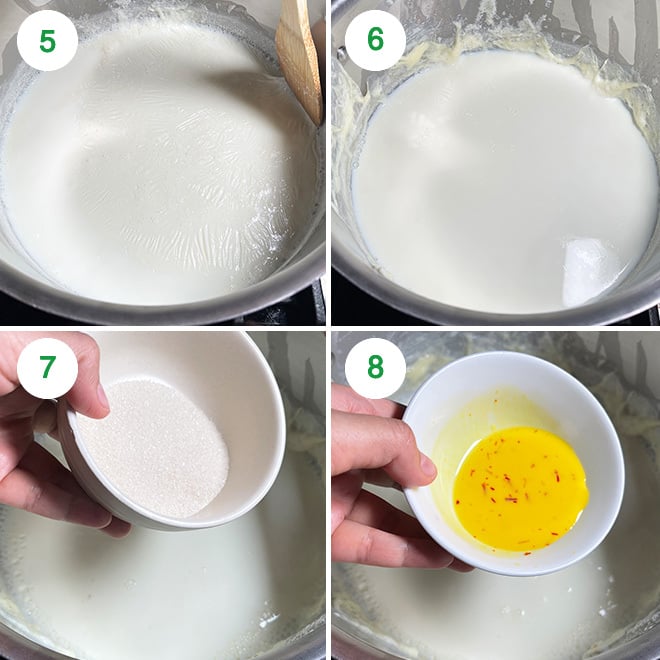
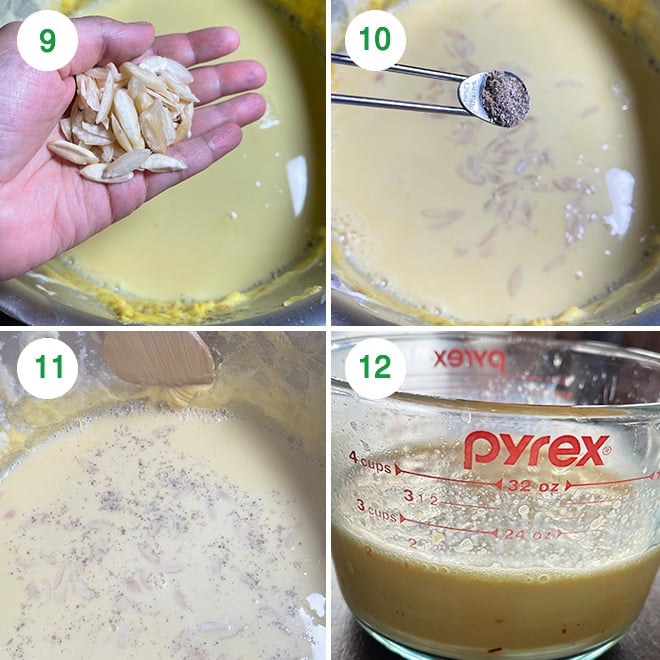
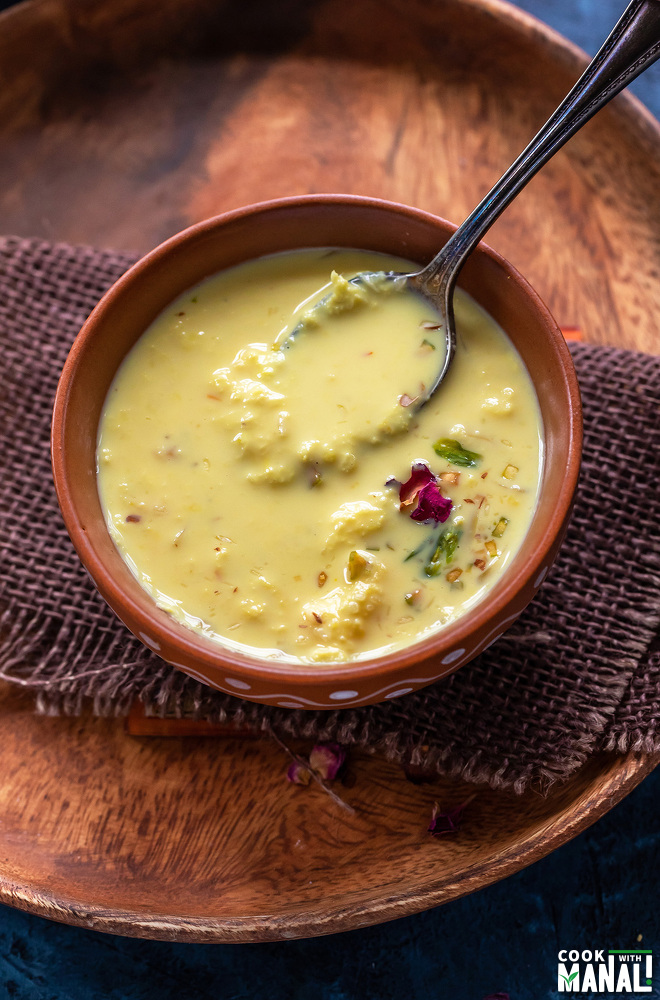
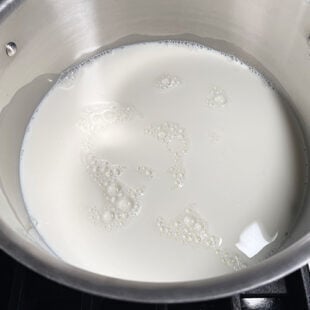
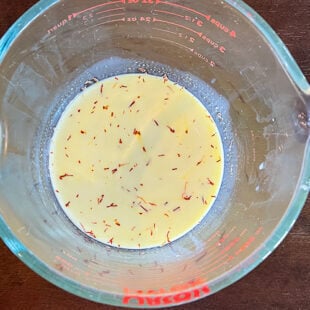
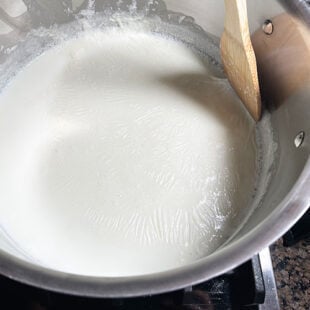
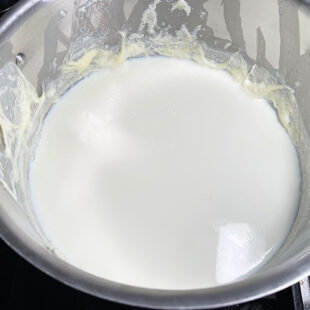
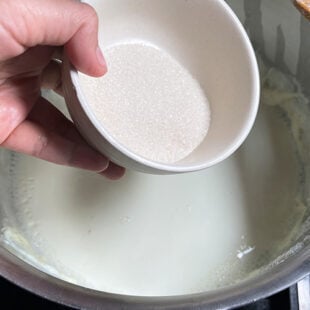
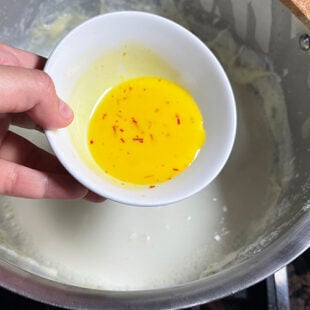
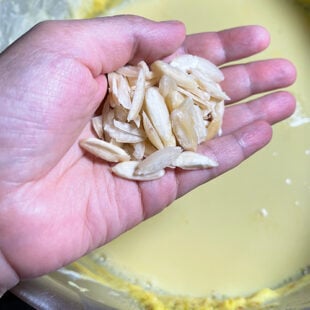
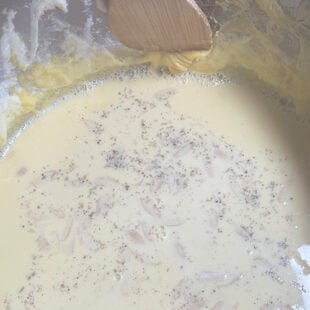
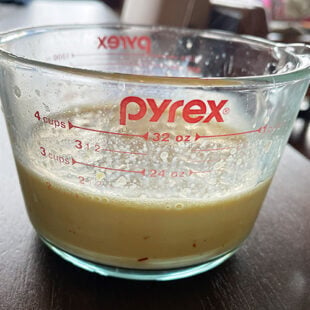

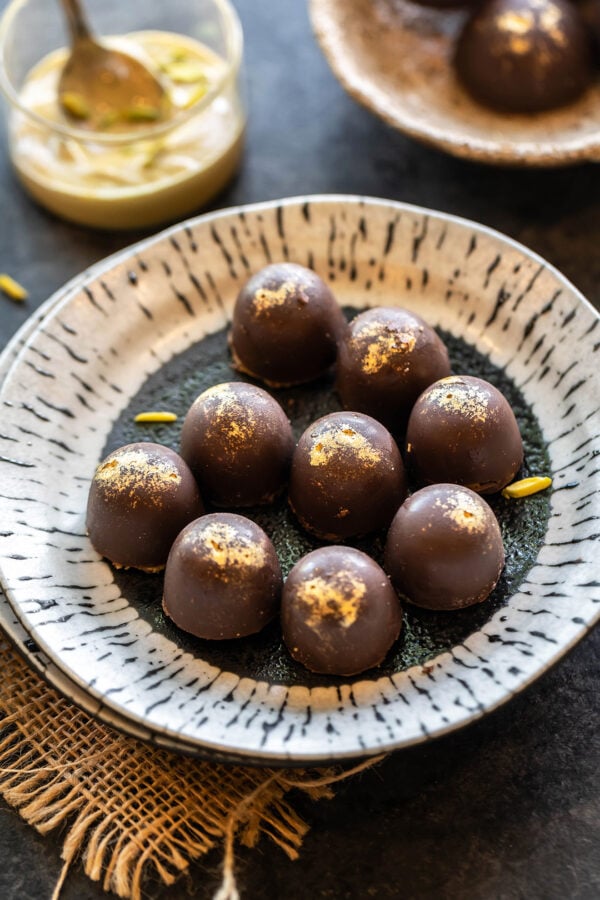
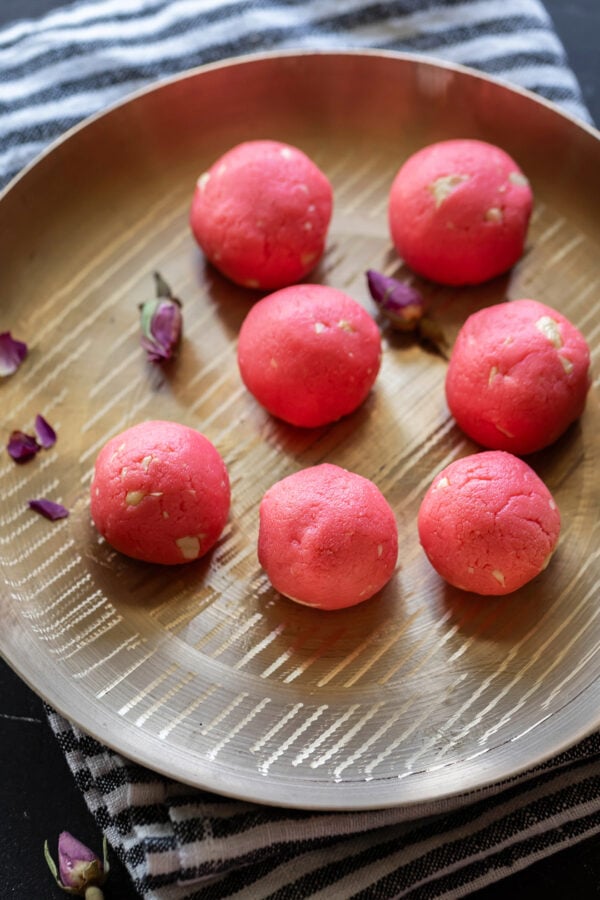
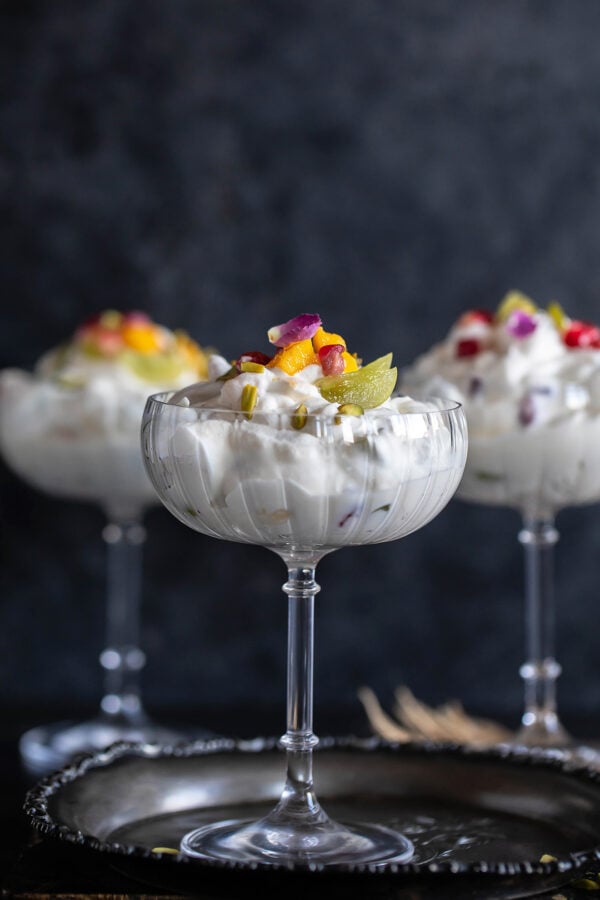
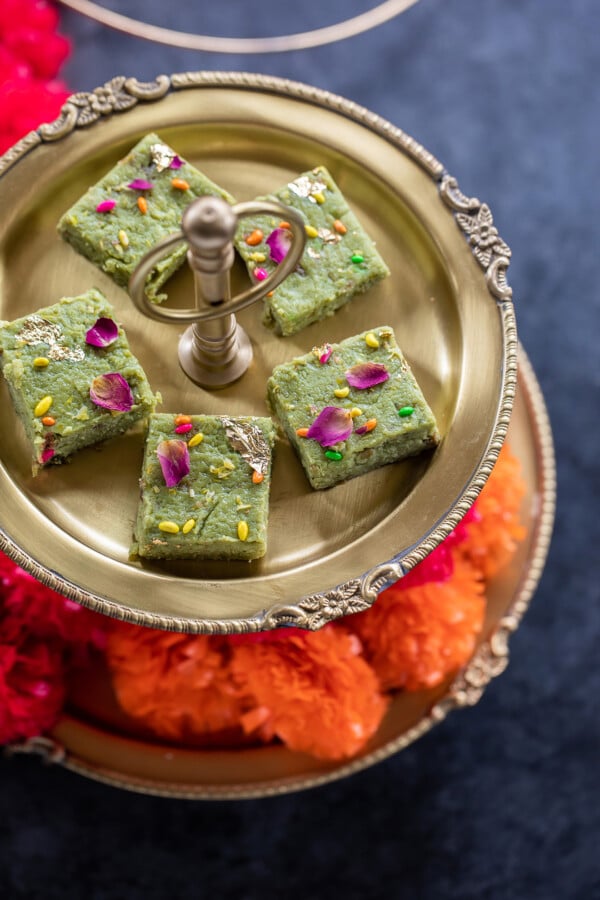









Your step by step directions in details are just amazing. Also emphasizing on the pot and the brand makes it efficient. Thankyou. It was delicious…
glad to hear Nina!